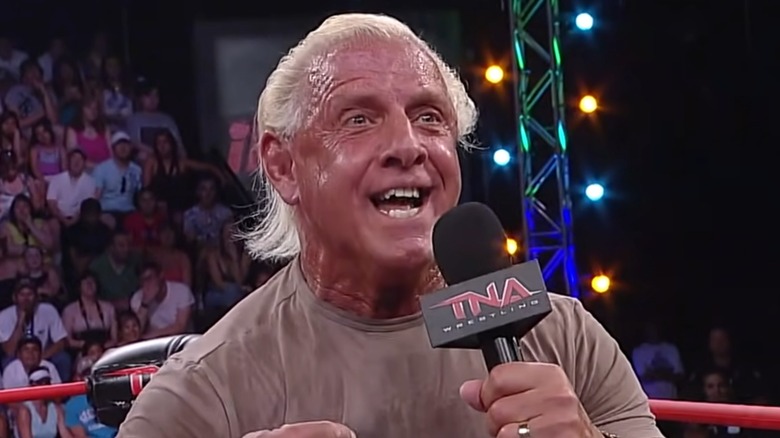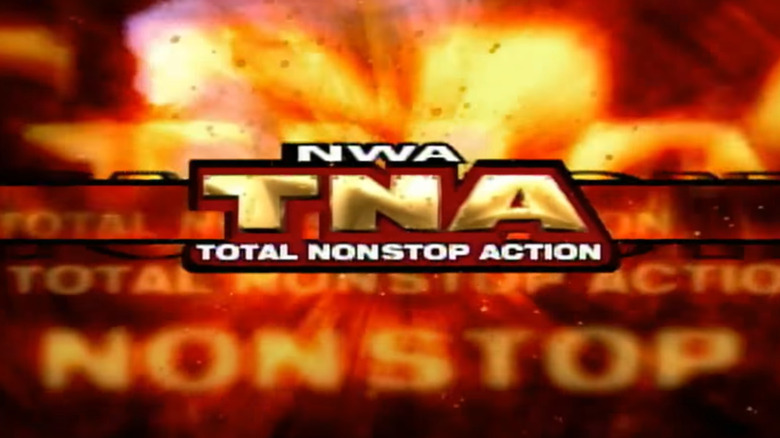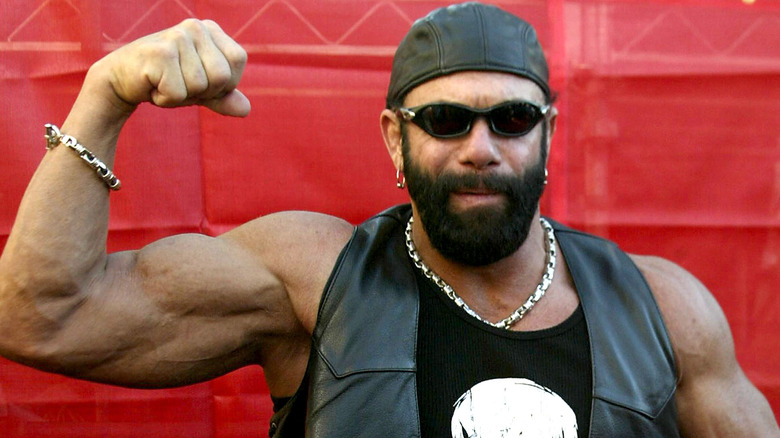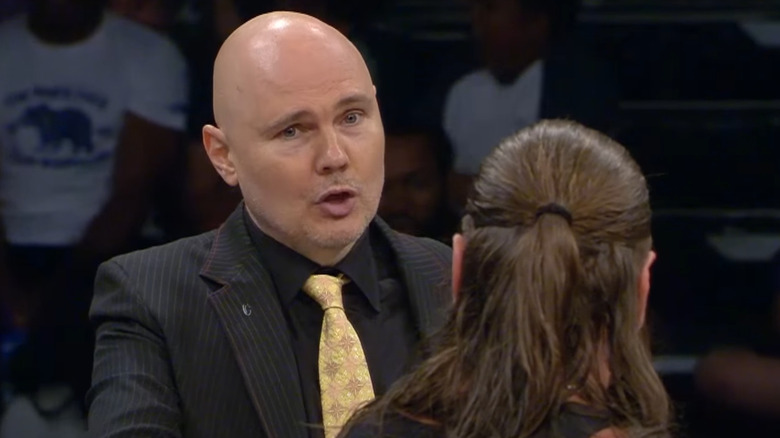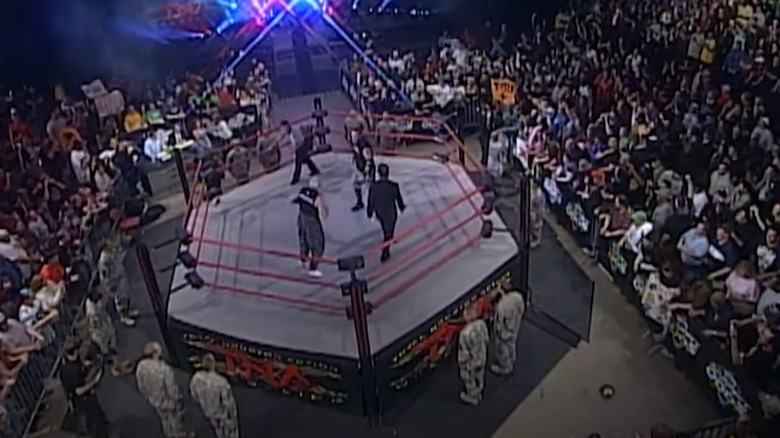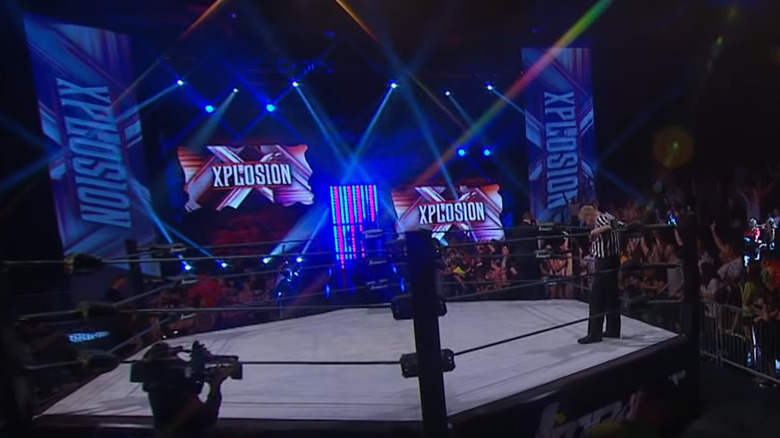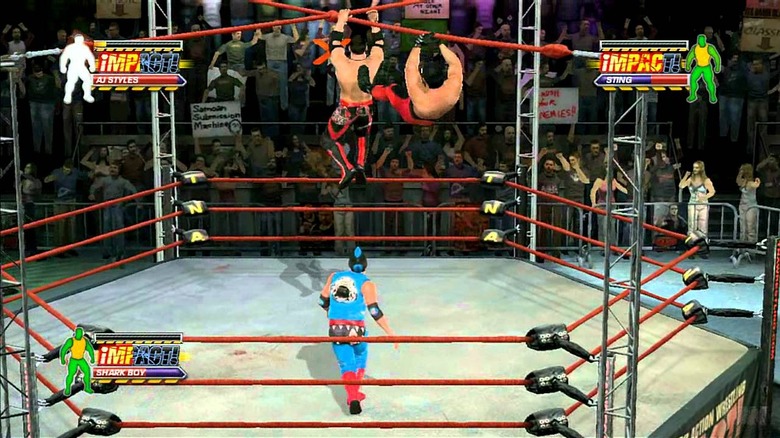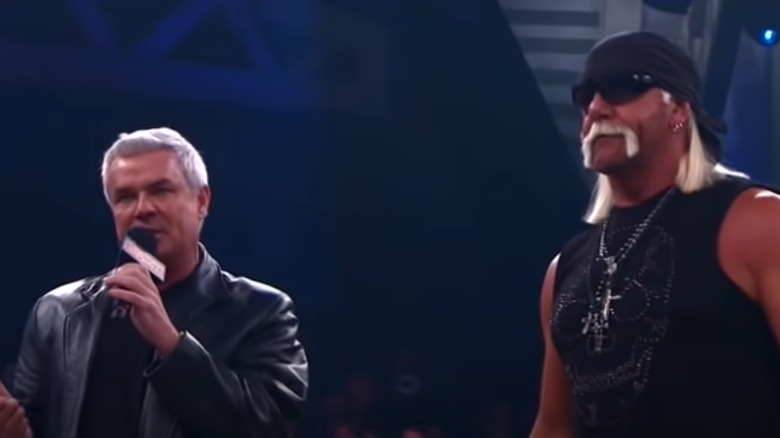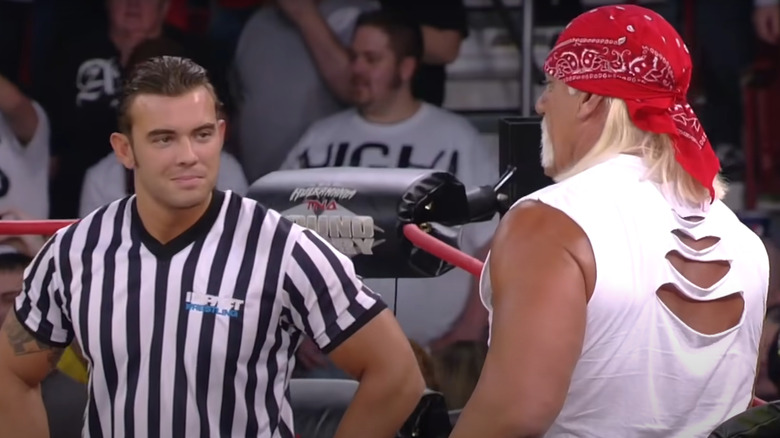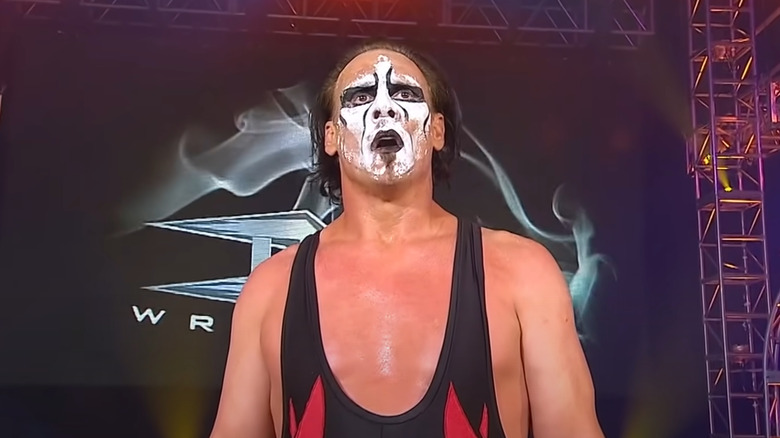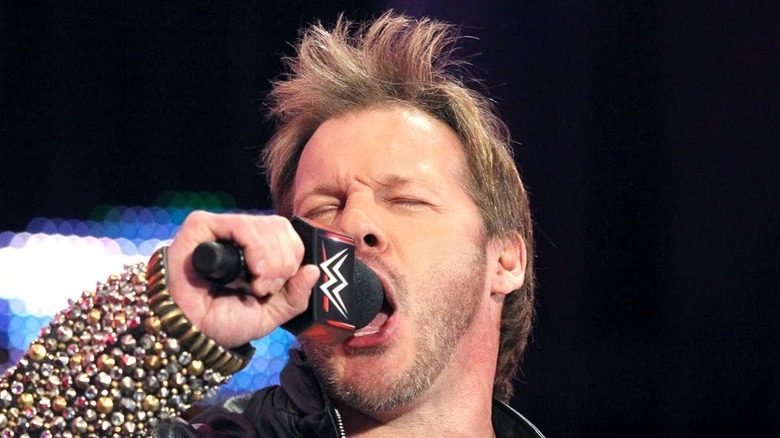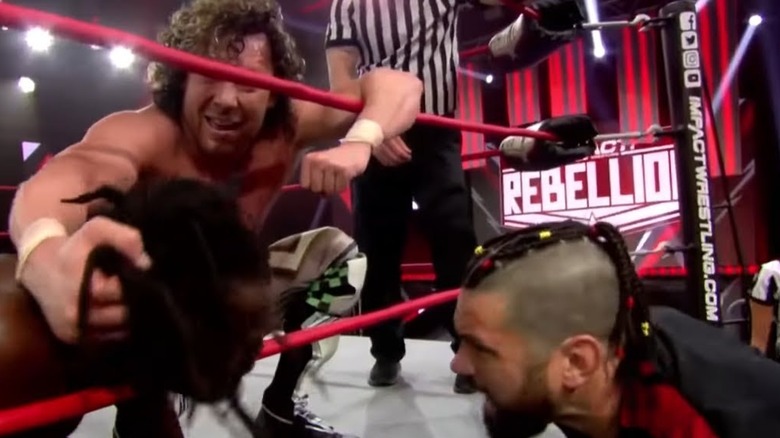Facts About Impact Wrestling That Only Hardcore Fans Know
We may receive a commission on purchases made from links.
In 2001, the WWF dominated the wrestling scene after they bought out their competition of WCW and ECW. There was a desperate need for an alternative that had some exposure. In 2002, Total Nonstop Action (TNA) was born with the idea that the now, WWE, was starting to get stale coming off the Attitude Era. TNA was here to give fans the alternative they craved.
From 2002 to the present day, TNA/Impact Wrestling has gone through many changes from a slew of different owners and investors, to many changes in production, to jumping to different TV networks all while trying to maintain its fanbase. In 2017 (per Wrestling News), TNA rebranded to be called Impact Wrestling in hopes of leaving the past behind and creating a semi-fresh start to the brand. Throughout its long history, Impact Wrestling is the company/brand that will not die. In fact, the brand has poked fun at itself by creating an annual pay-per-view event called Hard to Kill. With a company that has been on life support multiple times in the last decade, there is a lot to unpack in Impact Wrestling's history.
Impact Wrestling used to be weekly pay-per-views
After the boom of wrestling in the late 1990s and early 2000s, TV networks began to cool off about wrestling, as ratings were not improving or returning to where they were during the Monday Night Wars. When TNA hit the scene in 2002, finding a network that wanted to take a risk on a new promotion with low production value was hard to come by. Instead, TNA management, who at this time was primarily Jeff Jarrett and his father Jerry Jarrett, decided that a ten dollar pay-per-view every Wednesday model would be the most profitable and easiest to get the brand off the ground. According to "Pro Wrestling FAQ: All That's Left to Know About the World's Most Entertaining Spectacle," TNA thought they would be able to score a few extra pay-per-view buys from men who thought they were buying a "T&A" pay-per-view instead.
For a company that branded itself as a "WWE alternative," there was a lot of WWE-esque pieces to the first weekly pay-per-view show. There were country music singers, an Elvis impersonator, a NASCAR Driver, and a weirdly booked post-main event after Ken Shamrock won the NWA TNA Title. However, TNA did show some hope with their X-Division on the show and it started to become clear that if they wanted to be a true alternative, they would need to make some tweaks to their presentation.
Randy Savage had a brief run with the company
In 2004, Randy Savage showed up at TNA's Victory Road and confronted Jeff Jarrett. This was a huge appearance from a huge star in a relatively small company. Savage appeared a few times on "Impact" to build a feud against the Kings of Wrestling, made up of Jeff Jarrett, Kevin Nash, and Scott Hall. Savage found teammates in Jeff Hardy and AJ Styles. This setup a match between Randy Savage and his newfound teammates to take on the Kings of Wrestling at TNA's Turning Point pay-per-view later that year. Randy Savage and team won that match in what would be Savage's last match.
Unfortunately, much like the Randy Savage of the late 1990s, he was difficult to work with in many aspects. Savage ended up leaving quickly due to disagreements with the finish to a proposed NWA World Championship match against Jeff Jarrett at the Final Resolution pay-per-view in 2005. Macho Man's TNA run was very forgettable and former TNA wrestler Petey Williams described Savage's run thusly in "The Genesis of TNA" (via 411 Mania): "I don't think [Savage] did much for the company honestly; literally he was there for like a PPV and maybe two TV shows. I think he was there for honestly a month, I mean he didn't do much." This was the last time fans would see the Macho Man inside a wrestling ring, and it is a shame for his career to go out with an anti-climatic run.
TNA/Impact Wrestling has a long history of owners/investors
One thing that made the WWE/F consistent in its ideas and presentation is that one man, Vince McMahon, always had the final say in the operation. TNA never had that consistency because the change in ownership and investors often tugged the product in different directions. In the early days of TNA, Jeff Jarrett and Jerry Jarrett financially backed the product through a company called HealthSouth Corporation. Per former TNA employee Bill Behrens at WrestleZone, the Jarretts found themselves in financial trouble after the weekly TNA pay-per-view shows were pulling in lackluster buy rates.
After the Jarretts backed out, the company desperately needed an investor. This is where Dixie Carter came in and bought the company with financial help from her father's company, Panda Energy (via PW Insider). Dixie Carter and Panda Energy had a long run, but after some very questionable decisions over the years — like bringing in Hulk Hogan and Eric Bischoff to run the show — Panda Energy backed out of their investment in TNA and once again the company was on life support. In 2015, Billy Corgan, of Smashing Pumpkins Fame, and Anthem Sports and Entertainment entered the fray. Corgan ran the company for a short time, but had a falling out with Anthem Sports. Anthem still owns the company today, but the lack of consistency has hurt the fan following that Impact Wrestling once had.
The six-sided ring gave the show a different a feel
For decades, wrestling fans were accustomed to a square wrestling ring — four sides and four corners. TNA wanted to change that custom and create a look that was not status quo. Jeff Jarrett thought a six-sided ring would give the overall look of the show a unique appearance and provide the X Division wrestlers more chances for high-flying, creative moves. Jarrett borrowed this idea from Lucha Libre wrestling in Mexico, which often uses a six-sided ring. The problem was that many wrestlers only knew how to wrestle in a four sided ring, and the hexagon shape of the six-sided ring gave simple things like running the ropes a little more of a learning curve. In addition, some wrestlers mentioned that parts of the ring were harder than usual.
Although the reception of the wrestlers in the company was often negative, there was a lot of money to be had from this concept. Not only was the ring eye catching to anyone flipping through the channels, but it opened the door to many different licensing deals. During an episode of "My World with Jeff Jarrett" (h/t WrestlingNews.co), Jarrett said, "The six-sided ring changed our licensing game. The brand, as far as selling video games, Acclaim and all that came with it, yeah, we made some money off that." Unfortunately, the six-sided ring is no more, but it holds a big place in TNA history.
TNA had a second show called Xplosion
It is common practice for major wrestling shows to have a smaller, less important program that showcases wrestlers who are not on the main weekly show. These "dark matches" and the related secondary programming help create a longer live event experience and lets the company know how their less well known characters are doing in terms of crowd reaction. From the start of the company in 2002, TNA had a one-hour show called "TNA Xplosion." Much like their weekly show "Impact Wrestling," "Xplosion" found itself rebranded multiple times and bounced around to different broadcast networks (per PW Torch).
In 2021, Impact Wrestling ditched the name "Xplosion" altogether and instead revamped the show into "BTI: Before The Impact." "BTI" is a show that takes on a more pre-hype format to the "Impact Wrestling" weekly show. There is a panel that discusses the upcoming episode of "Impact" immediately after "BTI." There are some matches mixed in as well and often times the "BTI" matches and segments are referenced on "Impact," making the show feel a little more important than glorified dark matches for the live audience.
There was a TNA video game
WWE video games have dominated the market for many years and, in 2008, TNA wanted to try to throw a monkey wrench in that by creating their own Impact branded video game developed by Midway Games. The game — titled "TNA Impact!" — had a much smaller budget than any WWE video game. The game received average reviews, with the move sets being repetitive and some of the match types being unenjoyable to play. That being said, the game was different from WWE games, with the ability to play within the six-sided ring and play out TNA's signature match, Ultimate X. TNA had plans to release a sequel to this game after learning from some mistakes of the first one.
In 2009, Warner Brothers purchased Midway Games and the license of the TNA video game. Later that year, SouthPeak Games announced they acquired the TNA video game license and released a very loose sequel called, "TNA Impact!: Cross the Line!" in 2010 for Nintendo DS and PSP. This wasn't really a true sequel, as it was essentially the same game as the first one, but with a few new characters and features added into the mix. Although another Impact Wrestling game is possible in the future, the bankruptcy sale of Midway and the TNA video game license getting lost in the shuffle means that we've yet to see a sequel (via Kotaku).
Impact gets chased off of Monday nights and things go from bad to worse
When Eric Bischoff and Hulk Hogan were running the creative side of "Impact," there were many questionable decisions made based primarily on ego. One of the biggest ego moves under the Hogan/Bischoff regime was moving "Impact Wrestling" to Monday nights to run head-to-head with "Monday Night Raw" on January 4th, 2010. Hogan and Bischoff brought in a bunch of talent past and present in hopes to bump ratings in this new Monday night venture. The idea was dead in the water from the beginning because "Impact Wrestling" did not have even close to the fan base that WWE had acquired over the years. About five months later, "Impact" had to retreat from Monday nights because it was getting clobbered by "Raw" in the ratings. Things began to spiral for the Hogan/Bischoff camp from there.
Shortly after, Eric Bischoff sued TNA saying that they owed him money. In an episode of the "83 Weeks Podcast" Bischoff describes the lawsuit: "When I left TNA, they owed me $120,000-$130,000 ... flat out breach of contract, just quit paying." TNA was financially hurting at this time and to make things worse, most of the talent that Hogan and Bischoff had brought in to help boost ratings had left the company by the summer of 2010 — including Sean Waltman, Scott Hall, and Orlando Jordan (via PW Insider).
Garrett Bischoff was pushed heavily, but flopped hard
The biggest problem with Eric Bischoff being in charge of TNA for a time was letting his own ego get in the way of the product. Evidence of this can be found with how Eric tried to push his own son, Garrett, as the next big star in the company. Garrett Bischoff started as a referee and got involved in a storyline while refereeing a match between Hulk Hogan and Sting. Garrett was supposed to screw Sting out of a match at Bound for Glory, but found himself conflicted when Sting had the Scorpion Deathlock on Hogan. Garrett reluctantly rang the bell after some time, going against his orders and putting him on the receiving end of a chair shot from his own father.
This moment was supposed to set Garrett up for a big face run in the company. The problem was, the fans did not see him as a believable face. TNA Management did everything to try to get him over like, aligning him with the biggest faces in the company and having Hogan give him the rub by calling him the "future of pro wrestling" (via PW Torch). Unfortunately for Garrett, the fans were in the right here and his career was never what his father had thought it would be. Garrett wrestled on some independent shows after leaving TNA, but was most recently seen back in "Impact" for a cameo appearance with Aces and Eights (via WhatCulture).
TNA teased Sting's retirement at Bound for Glory 2009
When TNA was thriving it had some high caliber matches on their pay-per-views. This was the case for Bound for Glory 2009, when AJ Styles faced Sting for the TNA World Heavyweight Championship. The build to this match saw the veteran, Sting, lighting a fire under AJ Styles for months. Inevitably, it led to the two facing off for the biggest prize in TNA. The match itself is considered a little underwhelming with Styles retaining the World Title, but — as noted by PW Torch — it is what happened after the match that is more memorable.
After losing, Sting began to make his way backstage, but AJ Styles called him back into the ring. Sting mentioned that people were asking him all weekend if this was truly his final match while the crowd chanted "you still got it" and "one more year." Sting went on to mention that all the love of the fans made him want to wrestle forever, but there was never a clear answer on whether Sting was ready to retire. Little did we know that in 2022 we would watch Sting jump off a balcony through four tables at an AEW pay-per-view.
Chris Jericho was teased for an Impact event in 2018
Chris Jericho is a wrestler who has jumped all over the wrestling world and has reinvented himself on numerous occasions. Jericho has been in WCW, ECW, and WWE/F, but had never graced his presence in TNA. It wasn't until 2018 when Jericho appearing on "Impact" actually seemed plausible. On the August 30th, 2018 episode of "Impact Wrestling," fans were chanting "We want Jericho!" Impact's Twitter account acknowledge these chants, going as far as tagging Jericho in the tweet. To add to the tease, "Impact" announcers Josh Matthews and Don Callis reacted to the chants on commentary (via Sportskeeda).
In true Jericho fashion, he added to hype when he did an interview on the "Wrestling Perspective Podcast" (h/t TPWW). When asked about the possibility of going to Impact Wrestling, he said, "At this point, I've done everything I could ever do in wrestling. I have a loyalty to WWE but not a death wish with them or anything like that where by hook or by crook I have to be with the WWE." Just a few years later, Jericho helped launch AEW and has been a big part of its success. Jericho never did appear in Impact Wrestling, but AEW and Impact Wrestling have worked together in the past so it may not be totally out of the question.
Kenny Omega boosted Impact's pay-per-view buys in 2021
The tail-end of 2020 was an exciting time to be a wrestling fan. Kenny Omega had just won the AEW World Title from Jon Moxley at Winter is Coming with the help of Don Callis. The end of the show made it clear that Impact Wrestling and AEW were about to have a working relationship in some form. In 2021, Kenny Omega was on a championship collection tour and he had his sights on the Impact Wrestling World Championship, which was held by Rich Swann at the time. Omega defeated Rich Swann in April 2021 at Impact Wrestling's Rebellion pay-per-view in a Winner Take All Match. This win added another championship to Kenny's collection.
This was also a win for Impact Wrestling as, per Pro Wrestling News Hub, the Rebellion pay-per-view was one of their most successful shows in years. It was believed to have 9,300 TV buys and had the highest stream numbers since Anthem had purchased Impact Wrestling. Although these numbers are low by comparison, this was seen as a huge win for Impact Wrestling, as the number of buys was around double what their previous pay-per-view had pulled. Despite these successful metrics, Impact Wrestling has a long way to go if they ever want to pull the numbers they once had when promoting matches with Sting, Kurt Angle, and Samoa Joe
